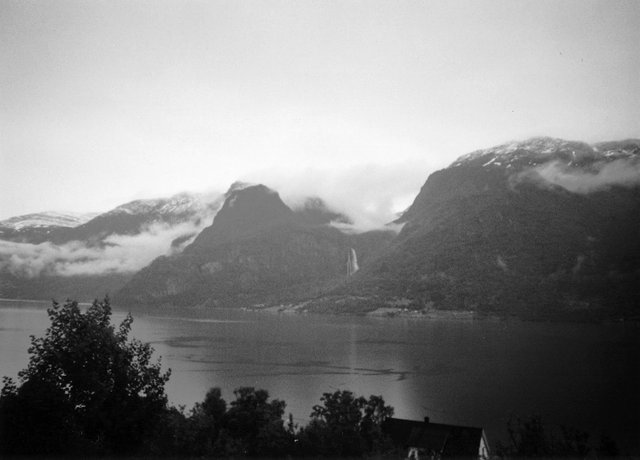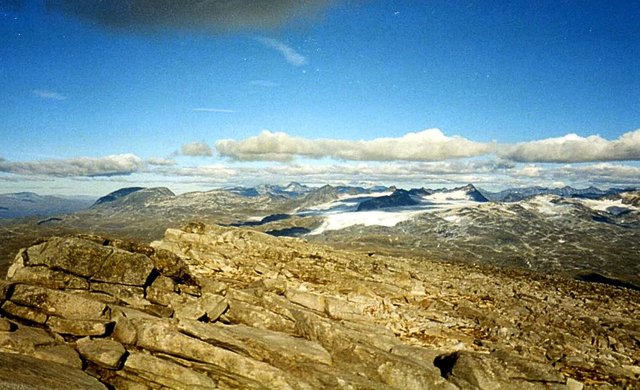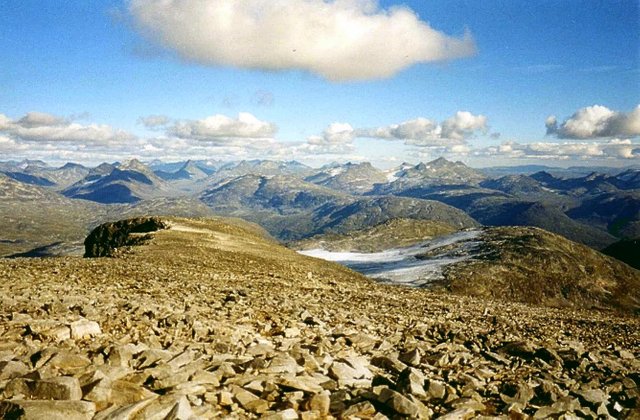Travels in Norway - from the Fjords to the Mountains
These two posts tell the story of a journey through Norway made a few years ago from the fjords to the mountains and the ascent of two peaks including the country's highest Galdhopiggen. Sorry about the photo quality as I was using one of those old disposable cameras but they give an idea of the places in the story and I hope to visit Norway again and bring back some higher quality photos of one of my favorite hiking locations. The summit views from Fannaraki were also from a subsequent visit as this time the weather was bad and there was nothing to see. So here's part one.
There was something eerie and primeval about the sound which was instantly recognizable even to someone who hadn't heard it before. More a wail than a howl, it rose and fell in the twilight of the northern night and was answered by another - a little closer but still some distance away - somewhere in the trees...
Wolves have lived in the forests of Norway for far longer than humans though in recent times they have been hunted almost to extinction and today only a few packs remain. As I later found out, the southern wolves here were normally much further east than this so I was lucky to hear them at all. Perhaps the late cold spell had driven them further west. I set off through the trees back to my cabin feeling a sense of reassurance that this enduring symbol of the wild was still out there.
A few days later, a chilly grey morning had seen me driving down a deserted road in a light rain from my cabin between Sogndal and Kaupanger in the county of Sogn og Fjordane in western Norway. I had driven past the cloud topped Storehaugen Mountain and followed the wide and gently winding road past walls of endless pines and rocky bluffs that rose above the glassy waters of the Sognefjord. Mine had seemed the only car on the road at that early hour.
Not long into my journey I pulled in at the side of the road to get a better view of a vast waterfall on the far side of the fjord. The falls which are called the Feigumfossen were awesome though such was the scale of this landscape that no sound could be heard across the fjord. After the recent rain the main fall which is 218 metres in height was fed by several tributary falls that dropped from the grey cloud ceiling from something over 600 metres or 2000 feet above the still water. The sense of peace here was absolute with the silent cascade opposite and the air motionless beneath the sheltering mountain walls. The rain too had stopped and a wintry blanket of white coated the higher hills where the cloud was starting to lift while ragged swathes of grey mist clung to the mountainsides below adding to the atmospheric nature of the view.

The Sognefjord near Kaupanger
It was time to move on again though. The dark Sognefjord became narrower as I approached its end and I was soon passing through the tiny hamlet of Skjolden at the extremity of the inlet. Here I passed some small wooden cabins - known as hytter - that faced the mirror-calm water and to where a brightening sky was framed between the walling mountains. Somewhere down there about 100 miles away was the open sea and this - the largest of Norway's fjords - is still tidal here despite the distance inland I was. The fjords themselves were carved out by the glaciers of the last ice age to a vast scale and unimaginable depth. The Sognefjord is in places over 4000 feet or 1200m deep which was about as high as the mountain walls were above it - a fact that I preferred not to think about on the occasions I had crossed it on the ferry! These huts you see by the water's edge are a traditional way of spending holidays in Norway and they originate from fishing and boating huts though are now to be found in the mountains and forests as well as by water. The more basic ones can be very good value for money in a country not known for bargains.
As I left the fjord behind, the landscape became even more dramatic - forbidding even. The road narrowed and followed a rushing river through low trees and meadow littered with boulders entering a narrow rocky defile or chasm in the mountains. Silvery ribbons of water cascaded from the clouds down vast grey crags seemingly thousands of feet high which threatened to block out the daylight. Now a layer of mist hung in the chill air just above the flat valley floor. If Tolkien's Stone Giants or the trolls of Norwegian legend did exist, it is here that they would be found.
As if in response to this sombre scene, the road suddenly emerged into the much more open meadows of Fortun which consists of a small group of colourful wooden houses situated in a meadow beneath steep and wooded mountain walls. The tiny village at first appeared to be the end of the road but the thin ribbon of tarmac could now be seen climbing the precipitous slopes behind the houses in a series of giddy hairpin bends. This was the infamous Turtagro road I had been told about. Climbing 2600 feet from Skjolden to Turtagro, the road was infamous for none other than Dutch Caravanners! Apparently they choose this route across the mountains unaware of the severity of this stretch of road and I had I began my ascent. Being used to the roads in the Lake District I found it OK and was very relieved not to meet any caravans coming down the single track route and so began to doubt their existence. Perhaps the chap at the campsite had been winding me up. The climb seemed to last forever as the road ascended to and fro up under the trees on the steep slope but the hairpins - though steep - were not as terrifying as Cumbria’s Hard Knott Pass. Soon the gradient began to ease and as I rounded one of the last bends there it was - no - not a troll though that would almost have surprised me less...
The look of apprehension verging on terror on the driver's face in the car coming the other way was as clear as the large 5 or 6 birth touring caravan he was towing. That guy in Sogndal hadn't been winding me up after all! The road here was not so narrow so I was spared reversing down 2500 feet of winding single track road and in my mirror I just caught sight of the Dutch NL sticker on the back of the caravan as I passed.
I left the trees and the steep slopes behind as the road entered a wide open region of grassy meadows and great craggy rocks. The Turtagro Hotel overlooked this wild scene and in fact was the only building of ant size in sight, Turtagro not being a village as such. I pulled onto the car park and went inside. The duty manager who was also a mountain guide - many are in places like this - told me that to ascend the nearby Fannaraki a peak of 2068 metres, I would not need his services or any special kit which cleared up some confusion. My map showed a path to a hut on the summit but my guidebook which was otherwise very informative suggested that ropes would be needed. They were possibly referring to Store Skagastolstind - Norway's third highest peak whose icy rock spire towered into the clouds to the right of Fannaraki and which does involve more difficult climbing.
The Turtagro Hotel itself was frequented by William Slingsby the English climber who made first ascents of many of Norway's mountains - including Store Skagastolstind - and the reading room here is full of fascinating mountain literature and faded photographs of the adventurers of old - including Slingsby. The manager told me that more recently there was an English climber who he referred to as simply "The Englishman" who came here to stay every year - I can't blame him! Anyway it was time I did some adventuring of my own so I left some of my gear and set off for Fannaraki. I crossed the road which was still empty - not even any more caravans from Holland - and took the path leading off it to the right a short distance up the hill.
The trail is a well marked track that heads off eastwards into a wonderfully remote valley called the Helgedalen, passing some deserted stone farmhouses and staying almost level for the first couple of miles before beginning a gradual traversing ascent of the slopes at the head of the valley. After climbing to the left, the main path resumed its eastward course which leads up and over the pass to the hut of Skogadalsboen in the Utledalen - the next valley to the East. My route however now parted from the wide track and crossed a rushing stream to begin a steep and relentless climb. A nice leisurely flattish walk is fine but it meant I now had 4000 feet to climb in not much over a mile.
The weather had now cleared somewhat though what the weathermen refer to as occasional showers were still moving up the valley and now was one of those occasional moments. The snow dusted top of Fannaraki had vanished in the cloud as had the jagged spires of Store Skagastolstind behind as I toiled my way up heathery slopes so steep that I could touch the ground with my outstretched hand - the path was easy though. As I got higher the cloud came down to surround me in its chill dampness and the heather gave way to rocks and bilberry. At least the angle of the slope had eased a little. Patches of snow began to appear.
For a short while I lost the path and found myself kicking steps up a shallow snow gully until I emerged at its stony top and found traces of path again. The cloud cleared a little to reveal the way ahead up a slope of snow covered rocks and a view across the valley to the misty serrated peaks and newly whitened glaciers of Store Skagastolstind and its range, the Hurrungane. The peak is 2403 metres - just short of 8000 feet - high and on its far side the range drops in spectacular fashion to near sea level in the mysterious woods of Vettismorki - a slope of alpine proportions indeed - this side of the range is impressive enough. Onwards I went and ever upwards. This reminded me of the tourist route on Ben Nevis - endless miles of stones - though unlike the Ben, I seemed to be the only person on this mountain. I now began to notice the altitude a little with a shortness of breath slowing my pace. Stopping for a rest I could see that I was level with the nearby peak of Steindalsnosi which my map revealed to be 1900 metres - before it vanished into another cloud and it started to snow.

North towards Galdhopiggen

The Jotunheim from Fannaraki
The slope eased out and became a bouldery plateau dappled with snow patches and I carefully negotiated the rocks until the uphill ran out and the 2068m summit was in front of me. It was important after crossing snow to clear your boots of the stuff before walking on rocks - an accident up here wouldn't make for the best of days out. The view was like that I’ve normally had from the Ben too - mist and cold damp rocks. I climbed Fannaraki again the following September when these photos were taken and the view is actually one of the best I've ever seen but alas - not today. I ate my lunch in the summit hut where the guardian told me I was the only one to climb the mountain that day, though the first week in June was still early in the season. He told me to take care on the descent and I returned to the cold outside where the weather had now developed into a minor snowstorm though it rapidly improved as I descended and my trek back along the Helgedalen to Turtagro was in pleasantly warm early evening sunshine with the golden light and long shadows typical of these northern latitudes. I took my time as getting benighted here isn't an issue at this time of year - I'd been able to read a book at midnight a few nights ago with no lights on. We're not quite far north enough for the midnight sun but it never goes dark in June.
The following morning would see me driving north over the arctic plateau of the Sognefjell to the small alpine village of Boverdal from where I would attempt to ascend the peak of Galdhopiggen which at 2469 metres or 8110 feet is the highest mountain in Norway and in northern Europe. The road - known as the Sognefjellsvegen - climbs from 800m at Turtagro to 1434m at its highest point as it makes its way across a rugged wilderness dotted with small lakes some of which are frozen well into the summer. Huge banks of snow follow the roadside in places where it has been dug out by the snowploughs and as it heads higher it is overlooked by a much less easy side of Fannaraki - a glaciated and alpine mountain face - before beginning its descent to the woods on eastern side of Norway. We enter a land very different to the fjords of the west but one which has a wild and rugged beauty of its own. The Sognefjell itself was crossed by Heinrik Ibsen in 1862 and helped to inspire the story of Peer Gynt and in those days the route was by a track marked out with cairns; the road itself not being built until 1938...
Previously posted at my blog Travel Stories and Short Adventures at "http://petebuckley.blogspot.com" part two can be seen here https://steemit.com/travel/@petebuckley/travels-in-norway-in-the-land-of-the-giants
God bless you. https://steemit.com/@biblegateway